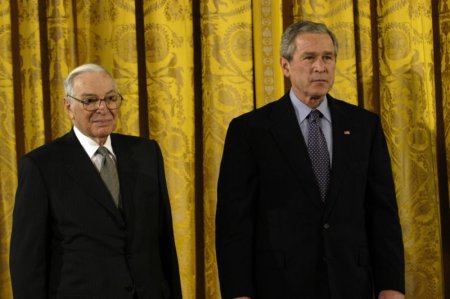focus and context, part V: choices and the collective (formation)

Kenneth Arrow and George Bush – Arrow receives the National Medal of Science, 2004
A previous randform post dealt with collective knowledges and in particular certain basic knowledges which were assumed to be connected with evolution. In the post it was asserted that collective knowledge may -among others- be hidden in the subconscious and that design/marketing may be a mean to detect something of it.
In this series of posts I haven’t yet really adressed the question of HOW a collective knowledge or preference assumes shape, but sofar rather focused on potentially involved mechanisms (maybe to be continued). And in fact the formation of collective preferences (related: the question of formation of coherence and focus) is a very, very difficult – but interesting – issue and this post here is only a first (and almost historical) glimpse into this matter.
Designers often try just to slightly “readjust” the appearance of a popular product, because the collective knowledge involved with the product is already well-established and successful. Big changes may have unpredictable results. So the (re-) formation of a collective knowledge is often a very gradual process, which is usually the more complicated the more communication takes place (making by the way viral marketing a quite difficult thing).
There is also a whole branch in mathematics and economy which deals with various aspects of the formation of collective preferences such as social choice theory. For the lazy ones I cite from Wikipedia (also if the article itself is a stub):
Social choice theory studies how individual preferences are aggregated to form a collective preference.
A pioneer on the domain of social choice theory is economist Kenneth Arrow (see above image). Kenneth Arrow contributed in many ways to the investigation of the formation of a collective choice, like e.g. in his book (which is an outcome of his Ph.D. thesis: Social Choice and Individual Values, which contains also his well-known Arrow-theorem (see also end of his Nobel Memorial Lecture, December 12, 1972).
His observations are often linked to the assumption that each individual can form an individual ranking (a “vote”) of a set of given preferences. Having this ranking one can then assume the existence of a “social welfare function”, which leads to a collective choice of the given preferences. Like for the case of real voting this “social welfare function” would be e.g. majority voting. However majority voting does not always work and as an extension to this paradox the arrow theorem states that there can be fairly simple assumptions on the desicion making process (like e.g. there should be no dictator) with which one can mathematically show that there exists no social welfare function. But yes – the assumptions are only assumptions and hence under discussion (especially the socalled independence of irrelevant alternatives assumption/axiom) etc. Nevertheless it is an interesting approach.
Another example of his works is the study of ecomomic equilibrium. In this mathematical branch it is studied how one can make quantitative assertions about how the individual demands are aggregated to form an equilibrium with the collective needs of the producers. Also here the problem of quantifying the individual preferences comes up – I cite from the Nobel Memorial Lecture, December 12, 1972, by Kenneth Arrows:
…one recurrent theme of economic analysis has been the remarkable degree of coherence among the vast numbers of individual and seemingly separate decisions about the buying and selling of commodities. In everyday, normal experience, there is something of a balance between the amounts of goods and services that some individuals want to supply and the amounts that other different individuals want to sell
which is hard to model given that
… In the pure model of a free enterprise world, an individual, whether consumer or producer, is the locus both of interests or tastes and of information. Each individual has his own desires, which he is expected to pursue within the constraints imposed by the economic mechanism; but in addition he is supposed to have more information about himself or at least about a particular sphere of productive and consumptive activity …
As a side remark: the individuality of the consumer is seen by some marketers as less diverse one may be inclined to think.
Another side remark: one should also note that in fact a big chunk of mathematicians/physicists are hired e.g. by banks. Among others they use mathematical models (like gauge theory for prices a.s.o.) for their work which includes among others decision making processes.